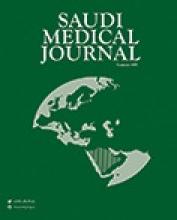Abstract
OBJECTIVE: To determine the prevalence of antimicrobial resistance among gram-negative aerobic bacteria isolated from infected patients on the intensive care unit (ICU) and the outcome of infected patients.
METHODS: Over a 5-year period (January 1998 to December 2002), all gram-negative aerobic bacteria (GNB) consecutively isolated from infected ICU patients at General Hospital, San Fernando, Trinidad and Tobago, West Indies. were tested for susceptibility to 10 commonly prescribed antimicrobial agents. Bacterial strains were identified according to standard microbiological procedures. The antimicrobial agents used and the amounts consumed by patients on the ICU were obtained from the hospital pharmacy records. Hospital discharges and deaths due to infectious complications were obtained from the medical records office and the ICU.
RESULTS: During the study period, there were 1160 admissions to the ICU. From this, 530 (45.7%) were suspected episodes of nosocomial infection and 445 (84%) were culture positive for GNB. Sputum, urine and blood accounted for approximately 85% of isolates. Pseudomonas aeruginosa (P. aeruginosa), Klebsiella pneumoniae (K. pneumoniae), Citrobacter spp and Enterobacter spp were the predominant isolates from sputum, while from urine; it was P. aeruginosa and K. pneumoniae. The major isolate from bloodstream infection on the ICU was Citrobacter spp. Of the 10 antimicrobial agents, the least effective was ampicillin that showed 87.8% resistance, while the most effective against GNB were imipenem (94.2%), ciprofloxacin (93.9%) and piperacillin-tazobactam (88.5%). The most common isolate was P. aeruginosa which is sensitive to >82% of the antimicrobials. Antimicrobial consumption was 2282 grams and the most frequently prescribed drugs were ampicillin, cefuroxime and amoxicillin-clavulanic acid, with consumption of the beta-lactam antimicrobials being 87.3% of the total. There were 280 (24.1%) deaths on the ICU during the study period and 42.9% (120 of 280) were said to be due to, or associated with overall hospital-acquired infectious complications. Mortality associated with GNB infection was approximately 33%. All fatal cases were associated with pneumonia and bloodstream infections. The predominant organisms were Citrobacter spp, Enterobacter spp, Acinetobacter spp and P. aeruginosa, with Citrobacter spp associated with both pulmonary and bloodstream fatalities.
CONCLUSION: In general, the isolates were relatively antimicrobial susceptible. Imipenem, ciprofloxacin and piperacillin-tazobactam were found good empiric choices for treatment of most GNB infection in the ICU. The study showed that resistance among ICU pathogens depended on the site of infection and that increased drug consumption of any antimicrobial agent may lead to increase resistance to those drugs. The need for policies governing the prudent use of antimicrobial agents cannot be overemphasized. Many endeavors aimed at introducing an antibiotic policy have encountered repeated failure and attempts at rational prescribing through educational programs have met with limited success. Hope is seen however, in proper implementation of infection control procedures aimed specifically to curtail lateral transmission of resistant organisms.
- Copyright: © Saudi Medical Journal
This is an open-access article distributed under the terms of the Creative Commons Attribution-Noncommercial-Share Alike 3.0 Unported, which permits unrestricted use, distribution, and reproduction in any medium, provided the original work is properly cited.






